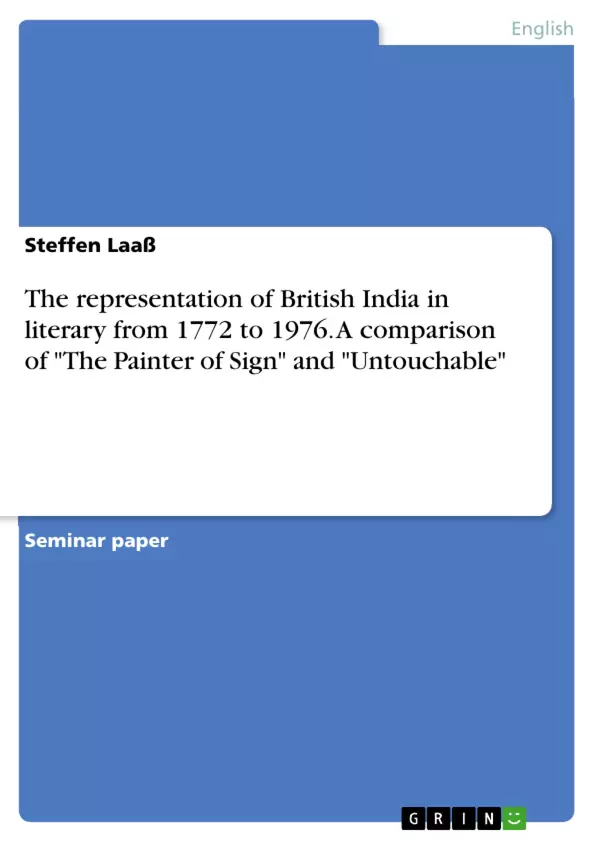The legacy of British colonialism in India is not only of economic or social nature, but also of highly literary interest. What makes the literature of British India so fascinating is first and foremost its depiction of the ‘other’, the exotic and unknown.
On the basis of selected representative texts by both British and Indian writers, this essay attempts to set out visible similarities and differences in Anglophone literature on India. To this end, Anand’s Untouchable and Narayan’s The Painter of Signs shall serve as core texts around which the comparisons will be centred.
It must be noted that representations of India do not embrace people alone, even though this is one of them most interesting and exhaustive aspects. Elements I will also elaborate on are the representations of landscapes and stereotypical images of India. As far as the British are concerned, it is the colonizers that are of primary interest here.
The literary material we will be discussing covers a period of more than 200 years – from 1772 to 1976. But it was only in 1978 when Edward Said published his most influential book Orientalism which studies the East through Western eyes. His vies will be used as a starting point for our investigation.
Inhaltsverzeichnis (Table of Contents)
- Introduction
- Said's East and West in The Land Storm and The Painter of Signs
- The romanticized India
- The representation of the British
- The representation of the Indians
- Conclusion
Zielsetzung und Themenschwerpunkte (Objectives and Key Themes)
This essay aims to analyze representations of "the British" and "India" in R.K. Narayan's "The Painter of Signs" and Mulk Raj Anand's "Untouchable" by comparing them to earlier literary texts on British India. It will focus on identifying similarities and differences in Anglophone literature on India during a period spanning from 1772 to 1976.
- The role of Edward Said's concept of Orientalism in understanding the representation of the East and West in literature on British India.
- The romanticized portrayal of India in British writing, focusing on the depiction of landscapes and stereotypical images.
- The representation of the British colonizers in literature, analyzing their perceptions of India and its people.
- The representation of Indians in literature, examining how different authors portray their lives, cultures, and experiences under British rule.
- The challenge to Orientalist perspectives through the examination of gender roles and power dynamics in literary texts.
Zusammenfassung der Kapitel (Chapter Summaries)
The Introduction outlines the essay's focus on analyzing representations of "the British" and "India" in Anglophone literature on British India, using Narayan's "The Painter of Signs" and Anand's "Untouchable" as core texts. The essay will also explore representations of landscapes, stereotypical images, and the impact of Edward Said's concept of Orientalism.
Chapter 2 delves into Said's theory of Orientalism, analyzing how it applies to Emma Roberts' poem "The Land Storm" and Narayan's "The Painter of Signs." It explores the power dynamics between the East and West, focusing on the stereotypical representations of India as primitive, backward, and feminine, while the West is portrayed as progressive, civilized, and masculine.
Chapter 3 examines the romanticized portrayal of India in British writing, focusing on the exotic and picturesque nature of its landscapes. It analyzes how Anand's "Untouchable" also incorporates idyllic and romantic moments, specifically in its depiction of the sun and sky.
Schlüsselwörter (Keywords)
This essay focuses on key terms and concepts such as British colonialism in India, Anglophone literature, Orientalism, representation of the East and West, romanticized India, stereotypical images, cultural difference, power relations, gender roles, and the works of R.K. Narayan, Mulk Raj Anand, and Emma Roberts.
- Quote paper
- Steffen Laaß (Author), 2005, The representation of British India in literary from 1772 to 1976. A comparison of "The Painter of Sign" and "Untouchable", Munich, GRIN Verlag, https://www.grin.com/document/114243



